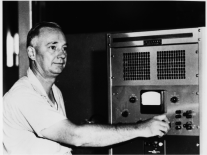
Grote Reber was an American pioneer of radio astronomy, which combined his interests in amateur radio and amateur astronomy. He was instrumental in investigating and extending Karl Jansky's pioneering work, and conducted the first sky survey in the radio frequencies.

A helium flash is a very brief thermal runaway nuclear fusion of large quantities of helium into carbon through the triple-alpha process in the core of low mass stars during their red giant phase. A much rarer runaway helium fusion process can also occur on the surface of accreting white dwarf stars.
Polarization is an important phenomenon in astronomy.

Mu Arietis, Latinized from μ Arietis, is the Bayer designation for a star system in the northern constellation of Aries. It is approximately 340 light-years distant from Earth, give or take a 30 light-year margin of error, and has a combined apparent visual magnitude of 5.74. According to the Bortle Dark-Sky Scale, this means it is faintly visible to the naked eye from dark suburban skies.
Jay Myron Pasachoff is an American astronomer. Pasachoff is Field Memorial Professor of Astronomy at Williams College and the author of textbooks and tradebooks in astronomy, physics, mathematics, and other sciences.

In astronomy, a circumpolar constellation is a constellation that never sets below the horizon, as viewed from a location on Earth. Due to Earth's rotation and axial tilt with respect to the Sun, the stars and constellations can be divided into two categories. Those stars and constellations that never rise or set are called circumpolar. The rest are divided into seasonal stars and constellations.
Vytautas Straižys is a Lithuanian astronomer. In 1963–65 he and his collaborators created and developed the Vilnius photometric system, a seven-color intermediate band system, optimized for photometric stellar classification. In 1996 he was elected a Corresponding Member of the Lithuanian Academy of Sciences. Straižys is an editor of the journal Baltic Astronomy. He is currently working at the Molėtai Astronomical Observatory. Asteroid 68730 Straizys in 2002 was named after him.

The University of Illinois Astronomical Observatory, located at 901 S. Mathews Avenue in Urbana, Illinois, on the campus of the University of Illinois at Urbana–Champaign, was built in 1896, and was designed by Charles A. Gunn. It has been listed on the National Register of Historic Places since November 6, 1986, and on December 20, 1989, was designated a National Historic Landmark.

Oton Kučera was a Croatian astronomer. He played a crucial role by popularizing science and technology in Croatia. He was also the president of Matica hrvatska and the author of several physics handbooks for primary school and a series of popular scientific works from the areas of physics, astronomy and electrical engineering.

Andrew Fraknoi is a retired professor of astronomy recognized for his lifetime of work using everyday language to make astronomy more accessible and popular for both students and the general public. In 2017 Fraknoi retired from his position as Chair of the Department of Astronomy at Foothill College. In retirement he continues to teach through the Fromm Institute for Lifelong Learning and the Osher Lifelong Learning Institute at San Francisco State University, to give public lectures, and to continue to add to his body of written work. He is the recipient of numerous awards and honors in his field.
1508 Kemi, provisional designation 1938 UP, is an eccentric, carbonaceous asteroid and one of the largest Mars-crossers, approximately 17 kilometers in diameter. Discovered by Heikki Alikoski at Turku Observatory in 1938, the asteroid was later named after the Finnish town of Kemi and the Kemi River.

1559 Kustaanheimo, provisional designation 1942 BF, is an stony asteroid from the inner regions of the asteroid belt, approximately 11 kilometers in diameter. It was discovered on 20 January 1942, by Finnish astronomer Liisi Oterma at the Iso-Heikkilä Observatory near Turku in southwest Finland. The asteroid was named after Finnish astronomer Paul Kustaanheimo (1924–1997).
1424 Sundmania, provisional designation 1937 AJ, is a dark asteroid and rather slow rotator from the background population of the outer regions of the asteroid belt, approximately 70 kilometers in diameter. It was discovered on 9 January 1937, by astronomer Yrjö Väisälä at the Turku Observatory in southwest Finland. The asteroid was named after Finnish astronomer and mathematician Karl F. Sundman.
1558 Järnefelt, provisional designation 1942 BD, is a carbonaceous asteroid from the outer region of the asteroid belt, approximately 65 kilometers in diameter.

Astronomy & Astrophysics is a peer-reviewed scientific journal covering theoretical, observational, and instrumental astronomy and astrophysics. It is one of the premier journals for astronomy in the world. The journal is published by EDP Sciences in 16 issues per year. The editor-in-chief is Thierry Forveille. Previous editors in chief include Claude Bertout, James Lequeux, Michael Grewing, Catherine Cesarsky and George Contopoulos.
The Société astronomique de France (SAF), the French astronomical society, is a non-profit association in the public interest organized under French law. Founded by astronomer Camille Flammarion in 1887, its purpose is to promote the development and practice of astronomy.

Erik Gustav Elfving was a Finnish mathematician and statistician. In statistics, he wrote pioneering papers about the optimal design of experiments. He made other notable contributions to the mathematical sciences and to Finnish universities.
Heikki Mannila is a Finnish computer scientist, the president of the Academy of Finland.
The Society for the History of Astronomy is an organisation based in the United Kingdom that promotes research into the history of astronomy. It publishes a research journal called The Antiquarian Astronomer and a regular Bulletin.













